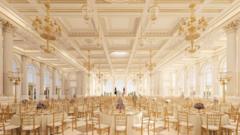Construction of a new 650-person ballroom at the White House is set to begin soon, fulfilling President Trump’s long-held aspiration to modernize state event capabilities without the need for temporary tents. The initiative is supported by both the president and anonymous donors, with a completion date anticipated before the end of Trump’s term in 2029.
Trump’s Grand Vision: A $200 Million Ballroom for the White House

Trump’s Grand Vision: A $200 Million Ballroom for the White House
The White House has unveiled plans for a new luxurious ballroom, aiming to elevate state events, with construction set to commence this September, funded by Trump and anonymous donors.
The White House has officially announced its plans for an opulent $200 million ballroom, catering to the growing demands of state events under President Trump's administration. This long-desired addition, designed to seat 650 guests, will be constructed alongside a revamped East Wing, which currently accommodates the First Lady’s office among other key staff.
Press Secretary Karoline Leavitt confirmed that construction will begin in September, funded by a combination of President Trump’s personal contributions and generous donations from unidentified benefactors. This ambitious project aims to replace the current use of the much smaller East Room, which accommodates around 200 guests. For larger gatherings, the White House often relies on temporary tents on the South Lawn, described by Trump as "unsightly."
In a media briefing, Leavitt referred to the new ballroom as a “much needed and exquisite addition” to the enduring legacy of the White House. She also assured that construction will finish well before Trump's term concludes in January 2029. This new space would help eliminate the logistical challenges of hosting state dinners and high-profile events, especially those frequented by world leaders.
Chief of Staff Susie Wiles expressed confidence that the historical integrity of the White House would be preserved in the renovation process, reflecting on the importance of such expansions in American history. Leslie Greene Bowman, a veteran of the Committee for the Preservation of the White House, echoed this sentiment, emphasizing the need to honor the history embedded within the existing structure.
Plans for the ballroom include architectural styles consistent with the White House's renowned aesthetics, featuring lavish chandeliers and intricate columns. Offices situated in the East Wing will undergo temporary relocations to facilitate the construction.
Trump has long touted the necessity for a new ballroom, even recalling a 2016 campaign promise to contribute $100 million for the project during Barack Obama’s presidency—a proposal that was dismissed at the time. Reflecting on the frequent need for tents for large presidential events, Trump remarked on national television how much improvement a proper ballroom would bring.
During a recent encounter in Scotland, Trump reiterated his commitment to creating the ballroom, which he believes will offer a stunning backdrop for presidential events. As conversations around the country’s political landscape evolve, this grand renovation is poised to play a significant role in how future administrations engage in official state functions.


















